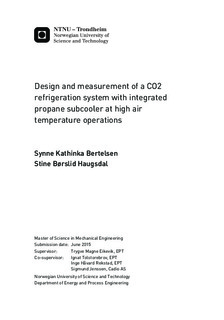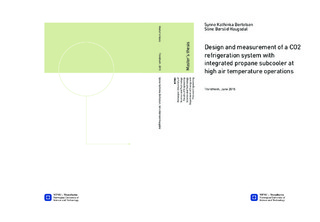| dc.description.abstract | After the rediscovery of CO2 as a prominent, environmentally benign working fluid, several technological modifications for the basic CO2 refrigeration cycle has been reviewed. These have been presented as solutions to the low Coefficient of Performance experienced in high air temperature operations. This is due to the great correlation between the ambient air temperature and the enthalpy after the gas cooler in the CO2 refrigeration cycle. Economisers, mechanical subcoolers, ejectors, expanders, CO2 integrated systems, parallel and auxiliary compression for flash vapour compression and evaporative cooling are technology solutions that mainly is implemented to reduce the energy consumption and the enthalpy before throttling in the basic CO2 cycles.
Cadio AS has developed a CO2 system with a secondary propane cycle for operation at higher ambient temperatures. The system has a CO2 gas cooler with integrated propane condenser and a propane subcooler that condenses the CO2. This allows subcritical operation at all ambient temperatures.
A prototype unit in a production facility at Heimdal was instrumented and tested during the project thesis work. Measurement data were corrected and the optimal point for start of the propane operation was found at an ambient temperature of 23,5 C.
Further, these measurement data has been compared to results from a simulation model developed using the Heat Exchanger simulation program (HXsim) and the Engineering Equation Solver (EES). Simulations showed that a propane set point corresponding to an ambient temperature of 19,4 C provides the best Coefficient of Performance.
However, when the propane system is not in operation, the refrigeration capacity starts to drop significantly from an ambient temperature of 15 C.
Several different modifications of the integrated condenser/gas cooler has been tested in HXsim. A minimum increase of 9 % in the Coefficient of Performance can be achieved when implementing an improved CO2 condenser design at an ambient temperature of 19C. By implementing a new propane condenser, the systems Coefficient of Performance can increase with 16,2 % at an ambient temperature of 40 C. By rising the fan speed, the performance of the system can be increased even further. When implementing the improved propane condenser, a smaller propane compressor can be applied, thus energy savings on the propane system can be achieved.
Performance of the system was tested for different European capitals. The seasonal performance in Madrid was found to be 2,85 in comparison to 3,22 in Oslo. The propane system also have almost three more months of operation in Madrid than Oslo, which clarifies the importance of the set point and efficient high temperature operations.
Various system modifications has been investigated and simulated in EES. The modified system that gave the best seasonal performance for the capitals with the warmest climates proved to be the mechanical subcooling system, even though the prototype system provided the best Coefficient of Performance at high ambient temperatures. The mechanical subcooling system also provided the best refrigeration capacity up to an ambient temperature of 37 C, where the prototype system competes when it comes to refrigeration capacity. The transcritical system with an internal heat exchanger had an improved refrigeration capacity of 5-6 % at high temperature operation compared to the simple transcritical system. This indicates a simple and cost-effective method for improving the refrigeration capacity of the system. | |

